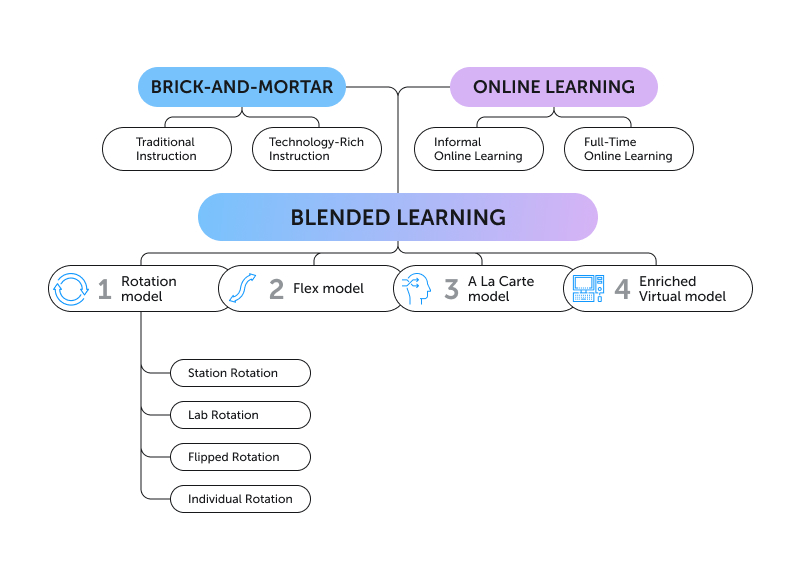Blended learning
This article examines blended learning and reveals ways it can help your organization to improve engagement and learning outcomes.

In this article, we will shed light on what blended learning is and discuss ways it can help your organization improve employee engagement and learning outcomes.
Plus, we will identify some common mistakes organizations make with blended learning and then, more importantly, highlight some best practices.
Discover:
- What is blended learning?
- The benefits of blended learning
- The drawbacks of blended learning
- Examples of blended learning
- Blended learning models
- Blended learning best practices
What is blended learning?
Blended learning is a type of learning that allows learners to utilize the ability to learn both face-to-face and online through digital platforms.
The goal is not to complement or replace conventional learning styles, but rather to incorporate necessary changes to make the educational path for learners more effective and personalized.
According to one study (Preparing for the Digital University 2015, page 71), blended learning has proven to generate better learning outcomes when compared with other learning styles, such as solely online or face-to-face.
The benefits of blended learning
1. Higher employee engagement
Through blended learning, employees have more opportunities to learn and engage.
They can learn from trainers face-to-face, and if they need to work more on a new concept or practice, they have access to all useful material online at all times.
Employees can revisit this material to strengthen their understanding on their own, and also meet with trainers to discuss questions and problems face-to-face.
2. More effective
Blended learning enables employees to learn through different styles.
Only learning face-to-face can increase dependency on trainers.
Being able to learn independently as well as face-to-face is empowering and motivating for employees.
Also, it allows trainers to manage training sessions more efficiently, especially when training large groups.
3. Increased flexibility
Employees have more opportunities to learn on their own, at their preferred pace and time.
Plus, training instructors are no longer bound to cover everything in the face-to-face training sessions.
They can break down the course for increased efficiency and have the freedom to decide what they want to emphasize in training sessions.
Also, if all employees are not on the same level, using an online learning platform means that every individual can be evaluated and given the attention they need to learn and make progress.
Overall, blended learning bridges the gap between what is taught and what is learned.
4. Saves time and money
Conducting online training sessions, when it makes sense, can save a lot of time and money.
For example, multinational companies often conduct training sessions in one location, and employees from other countries have to travel to be there.
Also, renting a large seminar hall to host a training session can be very expensive.
Therefore, from saving on travel costs to seminar rooms rental, blended learning minimizes operational costs significantly. In addition, it saves the time that companies have to invest in organizing training events on a large scale.
And some of the hours that it usually takes to go over everything in a face-to-face training can now be divided between online and in-person work.
5. Much more accurate analysis of learning
In a face-to-face training session, it can be difficult for the instructor to determine whether everyone is on the same page or not.
Some employees absorb the material quickly, while others might be struggling.
On the other hand, an online platform that contains various types of learning material, such as videos, ebooks, lectures, and presentations, can be used to track individual progress more effectively.
These tools incorporate built-in analytics that can evaluate and present a more accurate analysis of individual learning.
Thus, in a blended scenario, earning becomes more predictable, accurate, and measurable.
6. Something for everyone
Not every employee performs well during face-to-face training sessions.
Similarly, some might find the online-only learning platform too complicated.
Blended learning provides employees a perfect approach; with different modes of learning, everyone can benefit in one way or another and take advantage of the provided opportunities to learn and grow.
7. Improved communication
Face-to-face training by itself might not provide employees with the opportunity to communicate effectively with the instructor, especially in large groups.
With only a limited time allotted for the in-person training session, a trainer only can entertain a few questions as they need to cover all aspects of the training module.
With blended learning, online platforms become a part of the learning process.
At the same time, employees can find plenty of opportunities to communicate with the instructor and their team members through the dashboard and other built-in communication tools.
Similarly, employers and instructors can reach out to their employees more efficiently and assign different tasks, address problems, and discuss ideas more conveniently through the online platform.

L&D strategy framework
You will receive a list of questions along with a spreadsheet template to help you analyse your L&D strategy.
DOWNLOAD FRAMEWORKThe drawbacks of blended learning
1. Cost of implementation
The setup cost of developing and implementing a blended learning approach can be high, including the cost of ownership of an online platform.
Ensuring that the software is customized to meet specific learning goals can be tricky and tiring as it involves trial and error to identify which features to include and how to streamline processes for enhanced productivity.
2. Lack of IT skills
It is necessary to have a reliable tech support team on board that can also train the staff.
Otherwise, instead of helping, the new system can become challenging for both trainers and employees.
3. More work for instructors
The new learning approach can overburden trainers, especially in the beginning.
They might have to revamp an entire course to make it suitable for the new blended learning approach.
Plus, understanding how the new system works and how to make the best use of it inevitably means more work.
4. Misuse of the online platform
If trainers misinterpret the purpose of an online platform, they might begin using the online learning platform as a place to dump loads of educational material they do not want to go over face-to-face.
That density of the material can be distracting and even demotivating for employees.
5. Disturbance in the workplace
Implementing a new learning system in the workplace can be a challenge, as all staff members need to embrace the new approach to make it work.
Changes can lead to conflicts, causing a disturbance in the workplace.
Examples of blended learning
- Employees being introduced to new principles and procedures at work face-to-face, with relevant material and exercises available on an online platform that comes with built-in communication tools.
- Conducting short face-to-face coaching sessions with employees to connect with them and to observe their responses to various topics and issues, and then incorporating a blending learning approach that best fits their needs while maintaining a balance between face-to-face and online coaching.
- Chatting with employees face-to-face in a problem-solving session to mentor them, as well as providing them with online resources such as ebooks and case studies that they can access anytime. This supplies them with a perfect blend of in-person and online support to become a high-achieving team member.
- Providing employees with resources to learn online in the form of short courses, before having them out those new skills to the test with practical exercises at work. Such exercises could be done as a team, working on projects and tasks utilizing the training received through the online course.
- Having Employees review and learn training material in the form of videos and text online to get up to speed with new developments before deepening their understanding through face-to-face discussions with the instructors at work.
Blended learning models
There are four models of blended learning that offer different approaches employers/trainers can take to develop an advanced and personalized learning environment for learners.

1. Rotation model
This model is also a part of the traditional learning mode, but in a blended learning environment, online education is a big part of the rotation mix.
Following this model, employees of the same group rotate among different tasks and exercises, one of which is online learning.
This way, everyone gets to take equal part in all activities, like attending on-site training, watching online lectures, etc.
There are four different methods of implementing the rotation model:
a) Station rotation
As the name suggests, this approach requires employees to switch among activities, allotting equal time to every aspect of the training program and acquiring knowledge in the most practical and advanced ways.
Example: dividing employees into groups and assigning them different tasks in the form of stations.
For instance, group A starts at station one (online), learning a new subject by reading articles, watching videos, lectures, presentations, etc., while group B is at station two (also online), where they have to check for practical examples and case studies.
Group C begins at station three, learning through discussions and brainstorming face-to-face.
These groups rotate through these three stations.
b) Lab rotation
Similar to how employees rotate among different activities in the Station Rotation method, here employees rotate between face-to-face sessions and computer labs for online training.
c) Flipped rotation
This method involves switching roles between trainers and online platforms so that employees get all instruction and training online in the form of lectures and exercises.
During face-to-face sessions, trainers help them with problems and provide assistance where needed.
d) Individual rotation
Rather than managing the whole group in the same way, this method requires dealing with every employee’s training individually.
As everyone comes from a diverse background and has different strengths and weaknesses, based on their profiles, individuals rotate between online and face-to-face activities in a way that is most effective in improving their individual learning outcomes.
2. Flex model
With this learning model, employees are in charge and they learn mainly through online platforms, while the trainers are there to help them when needed.
It is empowering for the employees and makes them feel responsible, allowing them the freedom to decide how they want to learn, plus the relief of being able to learn at their own pace.
3. A la carte model
This model implies that employees can decide which courses they want to take online and in which they prefer to have face-to-face training sessions.
Either way, they have a trainer to help them with their learning, which could even be an online trainer.
This model is somewhat similar to the flex model, as it allows employees to choose how they prefer to learn for optimal learning outcomes.
4. Enriched virtual model
Under this model, employees follow a schedule provided by trainers that contain virtual learning as well as face-to-face training.
What makes this model unique, is that unlike a virtual-only learning system, where there is no on-site training, with this model employees must participate in on-site training when asked.
However, for the most part, they can obtain all learning material and engage in exercises virtually.
Blended learning best practices
1. The focus should be on improving learning outcomes
As there are various approaches that you can take, you need to choose one that helps improve employee learning outcomes in your organization.
At times, employers make the mistake of incorporating learning modalities that are trending.
The whole point of blended learning is to provide your organization with an opportunity to customize learning, so as to train your employees in the best way possible.
You should take an approach that is most suitable for your organization, regardless of what other companies are doing.
2. Measuring the impact of the improved learning process on business
Understanding how learning affects business is critical.
Alongside improving the learning process, it is crucial to track how it is affecting business operations overall.
An improved learning process should contribute to the increased productivity and performance of different departments.
3. Maintain a balance between online and on-site learning
The purpose of blended learning is to provide organizations with the ability to modify the learning approach to attain the best results.
It should not be used to avoid the responsibility of providing effective, ongoing training, by relying, for example, entirely on online platforms to conduct staff training.
When it is beneficial, take time out to offer on-site training, perhaps to introduce new changes or developments in the organizational structure to employees.
4. Make it more personalized
Employees come from different backgrounds, and they may or may not be familiar with blended learning.
Often, when something is new, some people might find it hard to take it seriously or might be unable to understand its purpose and benefits.
Therefore, your employees must share your vision and be on the same page.
Carry out proper training and face-to-face sessions to explain the blended learning approach, emphasizing its benefits.
Be sure to provide training for how to use the online platform and any different tools in order to remove any potential obstacles.
The key is to personalize the experience, so it is relevant and helps employees improve their learning outcomes.
5. Take a collaborative learning approach for increased engagement
Collaboration is critical to learning, as it helps employees brainstorm and develop new ideas.
When aligned with learning goals and within a structured environment, collaborative learning can be very impactful in terms of increasing team members’ engagement and fulfilling learning objectives.
You can implement this approach in various ways, such as through the online platform on its discussion forum, where employees can work on a problem collaboratively and come up with a solution within an allotted time.
6. Employee feedback and preferences are crucial
If you want to be successful in improving the learning outcomes, it is critical to know which learning approach is most suitable for your employees.
After all, what good is the ability to customize and make alterations in the system if you cannot use it to make specific changes based on learners’ preferences for better results?
Don’t just assume: conduct surveys and ask employees for their suggestions. That will also help increase morale and motivation.
7. Identify the problems blended learning can help you solve
As the old saying goes, don’t do things just for the sake of it; everything needs to be backed by a purpose.
To apply blended learning in your workplace, first, figure out why you need to change your current practices.
As there are so many techniques involved in blended learning, you have to know the problem areas that you will be targeting with the new approach in order to ensure it works out for your organization.
This way, you will be able to deploy a customized blended learning system that will prove its worth from day one.
8. Maximize process efficiency
Once you have identified the problems you are looking to overcome with blended learning, employ techniques that help you generate the best outcomes.
An example of this would be using on-site training to introduce new concepts while using online platforms to evaluate an individual’s performance through various exercises, or reinforcing what is taught in-person through short online videos and quick notes accessible to employees 24/7.
9. Incorporate practical based learning
If you want to test the waters and see how effective the deployed blended learning system is in your workplace, then get ready for some experimentation.
After all, what good is learning if it does not help in practical matters?
That is why you should think about bringing training and organization goals together in a way that enables employees to participate and use the training they receive through hybrid learning to achieve these goals while working in collaboration with their peers.
All of this should be part of the learning process.
10. Seek continuous improvement
So when everything is said and done and you have an effective blended learning system in place, can you move on and pay attention to other matters?
That is the kind of mistake employers often make.
We all know how frequently changes occur, and that nothing ever stays the same. And we all know what happens to those who do not change and grow with time.
Therefore, always keep an eye out for opportunities to improve whatever blended learning system you adopt.
Employee feedback, current trends, and other factors could be of great help in evaluating the effectiveness of the deployed system and seeing how it can be improved.

Build a learning culture: a practical workbook for your organization
Upgrade your organization’s learning culture with clear, actionable strategies to address the challenges.
Download workbook



